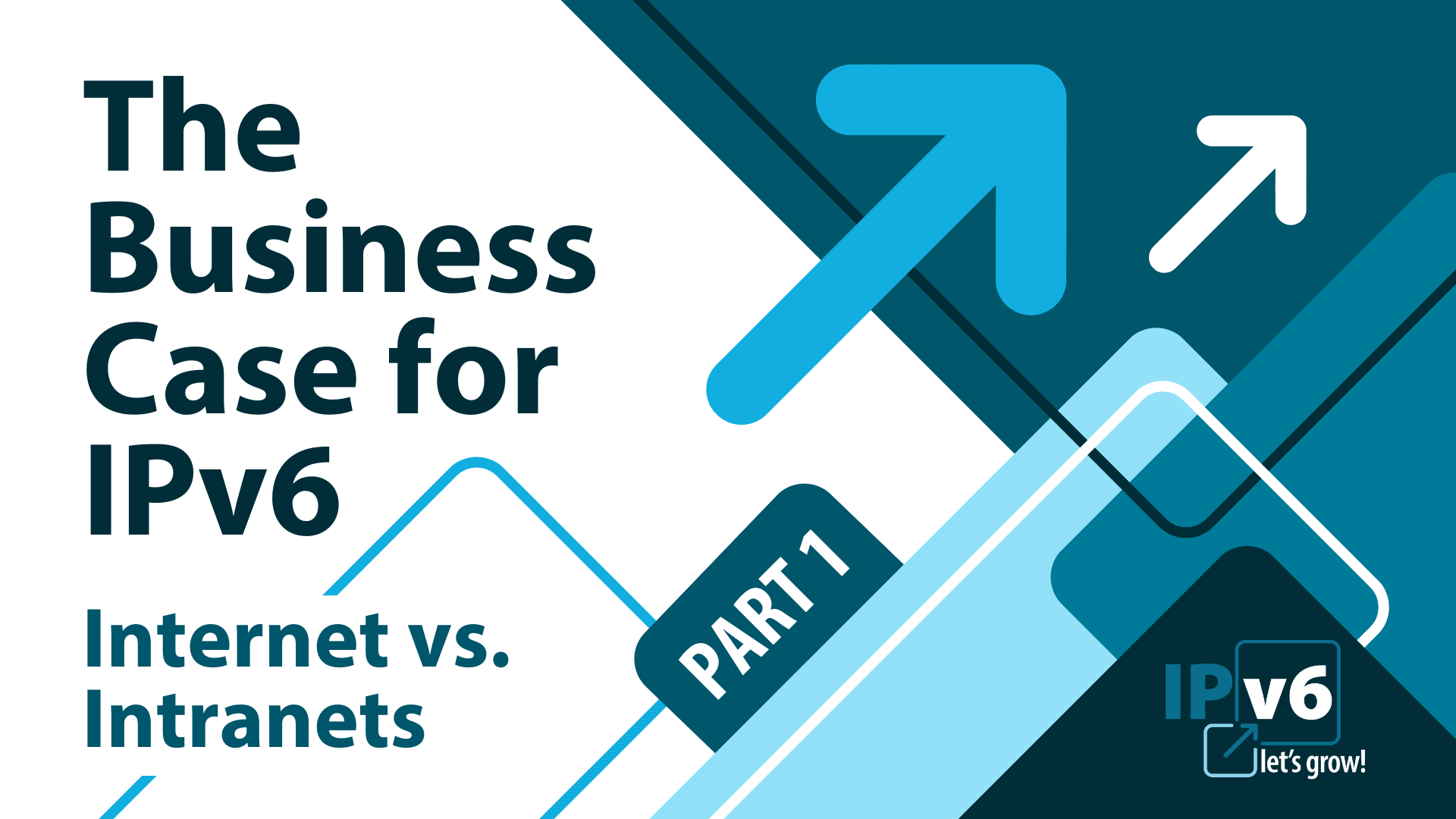
The Business Case for IPv6: Internet vs. Intranets
The Internet, by definition, is not a single network but rather a network of networks. Those constituent networks are independent, and their operators can freely choose when — or even if — to deploy IPv6. The name of a crucial Internet number resource is indicative of this independence: Autonomous Systems Numbers (ASNs).
So why does it matter whether other network operators are adopting IPv6? Well, if IPv4 and IPv6 were fundamentally interoperable, then, indeed, it would not matter whether other network operators were supporting IPv6; any network operator could choose to deploy IPv6 and retire IPv4. However, the IPv6 protocol defines communication only between IPv6 source and destination addresses, and IPv4 defines communication only between two IPv4-enabled endpoints.
Consequently, the transition from IPv4 to IPv6 is fairly complex and certainly protracted. The most common approach to overcoming this challenge is to deploy IPv6 alongside existing IPv4, in a so-called “dual stack” deployment. Other approaches, which aim to make part of a network IPv6-only, must also handle IPv6 to IPv4 communications through one of the numerous transition mechanisms available which exist precisely to help overcome the interoperability challenge.
As network operators consider how they will deploy IPv6, they also must come up with their business case for doing so. As with any allocation of time and talent, organizations must determine that it’s advantageous to invest their limited resources in the IPv6 transition. Many scenarios and motivations can play a role in the development of an organization’s business case to deploy IPv6. But before we explore those, let’s distinguish between the two fundamentally different types of IPv6 deployment: IPv6 for the Internet and IPv6 for intranets.
Two Types of IPv6 Deployment
The first type of IPv6 deployment is the enablement of so-called “eyeball networks” — residential or enterprise Internet Service Provider (ISPs) networks with users who consume content traffic directly attached — along with web and streaming content and consumer electronic devices. The intended outcome of this type of deployment is for IPv6 to be available and usable for general users to access the Internet from their devices on home Internet services and mobile networks. We’ll call this scenario “IPv6 for the Internet.”
The second type of deployment is the transition of enterprise networks to IPv6. Enterprise networks are employed by organizations of all sizes — including governments, businesses, and nonprofits — to connect employee devices and other stakeholders with IT infrastructure essential to the organization. Modern enterprise networks include many distinct network domains, often including office LANs (local area networks) and VPNs (virtual private networks), data centers, and cloud services. Additionally, many of these networks increasingly require extranet connectivity to communicate with the networks of third parties such as suppliers and partners. We’ll refer to this scenario as “IPv6 for intranets.”
IPv6 for the Internet
The case of IPv6 for the Internet includes deploying and enabling support for IPv6 across the networks facilitating Internet reachability. This includes fixed and mobile broadband networks. Within the fixed (or home) Internet scenario, we encounter the proliferation of electronic devices and bits of smart tech built with network capabilities.
Major stakeholders responsible for deployment and enablement of IPv6 for the Internet include:
- Internet service providers (ISPs)
- Home network equipment manufacturers
- Electronic device manufacturers
- Operating System developers
- Application (app) developers
- Content providers
ISPs’ IPv6 deployment is aided by the fact that home networks and mobile devices accept IPv6 quite well, with most users not even aware of its introduction. This is because the IP address assignment function for Internet-enabled devices within most home networks is handled by dynamic host configuration protocol (DHCP). In other words, if a new computer, tablet, or other device connects to the network, its IP address is assigned dynamically by the network.
When it comes to mobile networks, IPv6 deployment benefits from broad support for IPv6 from the major device operating systems over the last decade or so.
Expanding Its Reach
While each network operator has little (or no) control over IPv6 deployments on the networks to which their traffic is destined, the level of IPv6 deployment has been rising steadily since World IPv6 Launch in 2012. At that time, less than 1% of Internet users enjoyed IPv6 capabilities. As of early 2023, that figure is around 40% globally. As this figure continues to rise, the uncertainty regarding other networks’ support for IPv6 will become less of a discouragement to network operators evaluating the case for IPv6.
It would be difficult to overstate the significance of World IPv6 Launch, which was a watershed moment for the adoption of IPv6. In 2022 several panel discussions were held across the global Internet community to commemorate the event’s 10-year anniversary. I had the privilege of joining in a panel at NANOG 85 on 6 June last year, 10 years to the day since World IPv6 Launch. Similar panels were held at ARIN 49, APNIC 54, and RIPE 85 which provided an opportunity to reflect on the progress seen in the past decade and the current state of IPv6 adoption.
The consensus is that IPv6 has generally become common practice for many network operators, an observation borne out by global metrics. The good news for those who have not yet deployed it is that now there are more online destinations reachable by IPv6 than ever before. Other motivations for enabling IPv6 as a service provider range from the practical (such as mitigating the risk and cost of IPv4 address exhaust) to the principled (supporting IPv6 as the basis for future Internet standards). Subsequent articles will explore these motivations and elaborate the business case for ISP IPv6 deployments.
IPv6 for Intranets
Deploying IPv6 for intranets — or, in other words, enterprise networks — is significantly different from IPv6 for the Internet in several ways. Enterprise networks enable internal connectivity between domains such as office LANs and data centers, usually with a few controlled points of interconnection with outside networks (i.e., VPNs, web proxies, firewalls, and cloud services). Consequently, IPv6 deployment and its scope can more directly be controlled by an organization, though several non-trivial dependencies are stilled faced, including:
- Enterprise application support for IPv6 communications
- IT system application modeling of IPv6 networks
- Firewall change management systems support for IPv6 addresses
- IPv6 support from suppliers and partners
Additionally, some corners of enterprise networks may be burdened by older network equipment. This can become a tactical consideration since the enterprise-wide enablement of IPv6 may need to focus on newer and growing network domains. The considerations then shift to the practical matter of communication between domains and choices around transition mechanisms to be employed.
Motivations for IPv6 in enterprise networks are entirely practical. The cost of IPv4 will continue to rise, whether in direct capital costs of securing IP addresses, or operational expenses in paying for the use of provider-held IP addresses. Furthermore, many large organizations have already or have nearly depleted the private IPv4 addresses available for internal use (think 10.0.0.0/8, defined by RFC 1918).
As that address space is exhausted, enterprises must choose which compromises to make when tethering their network to IPv4. The shift to IPv6 can open a range of benefits, not least of which is the potential for IPv6 to offer highly scalable address schemes. As organizations seek the benefits of the cloud and automation at scale, they’ll find IPv6 is how to achieve it. Subsequent articles will explore these benefits of IPv6 deployments in enterprise networks.
The Business Cases
Due to the variety of stakeholder motivations across the two types of deployments — for the Internet and for intranets — one article cannot adequately describe all that could be said about the business case for IPv6. Instead, stay tuned to the ARIN Blog for subsequent posts in this series written by other guest contributors who are intimately familiar with IPv6 and the business cases that can help organizations embrace it.
Any views, positions, statements, or opinions of a guest blog post are those of the author alone and do not represent those of ARIN. ARIN does not guarantee the accuracy, completeness, or validity of any claims or statements, nor shall ARIN be liable for any representations, omissions, or errors contained in a guest blog post.
Recent blogs categorized under: IPv6
GET THE LATEST!
Sign up to receive the latest news about ARIN and the most pressing issues facing the Internet community.
SIGN ME UP →Blog Categories
RPKI • Updates • Outreach • Internet Governance • Grant Program • Tips • IRR • IPv6 • Public Policy • Caribbean • Elections • ARIN Bits • Fellowship Program • Training • Security • Guest Post • Data Accuracy • Business Case for IPv6 • IPv4 • Customer Feedback



